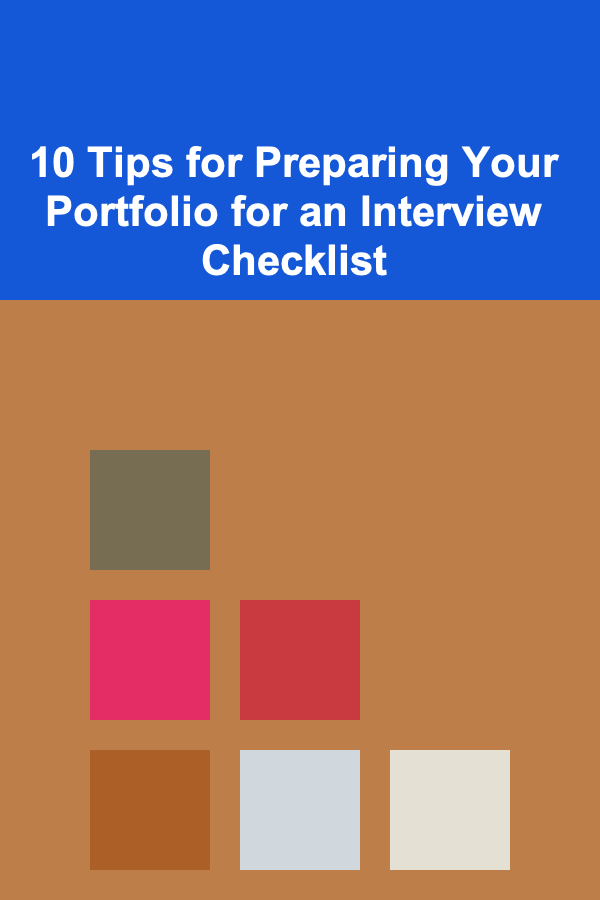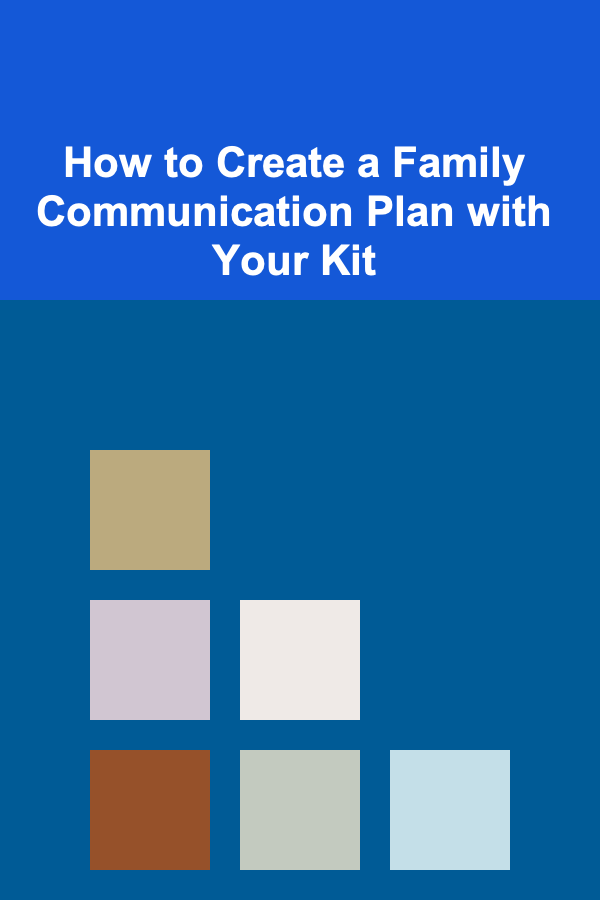
10 Tips for Preparing Your Portfolio for an Interview Checklist
ebook include PDF & Audio bundle (Micro Guide)
$12.99$10.99
Limited Time Offer! Order within the next:

Preparing an impressive portfolio is essential when you are heading to an interview. Whether you're a designer, developer, writer, photographer, or in any other creative field, your portfolio serves as a visual representation of your skills, experience, and personal style. It is your opportunity to show potential employers or clients what you can do and how you stand out from the competition. However, simply having a portfolio isn't enough---it's essential to tailor it to your audience and ensure it highlights your best work.
In this article, we will explore 10 actionable tips for preparing your portfolio for an interview, ensuring that it makes the right impact and increases your chances of success.
Tip 1: Understand the Job Requirements
Before you begin organizing or tweaking your portfolio, it's crucial to understand the job or role you are applying for. Every job has different requirements and expectations, and tailoring your portfolio to align with those is one of the most important things you can do.
1.1. Study the Job Description
Read through the job description thoroughly. Pay special attention to the specific skills, experience, and projects mentioned. If the position requires technical expertise or a particular set of skills, you should highlight work in your portfolio that reflects these abilities.
1.2. Understand the Company's Needs
Research the company or organization and understand their values, mission, and recent projects. If you can, try to identify the types of projects they've worked on in the past or the kind of work that resonates with them. This will allow you to tailor your portfolio to showcase projects that align with the company's needs.
Tip 2: Select Your Best Work
Your portfolio should include only your best and most relevant work. While you might have an extensive collection of projects, it's critical to curate the selection for quality over quantity.
2.1. Showcase a Variety of Projects
Ensure that your portfolio reflects your range of skills and abilities. Select work that demonstrates versatility, showing your ability to adapt to different types of projects. If you're a designer, for example, consider including branding, web design, print work, and any other relevant pieces that show off your range.
2.2. Keep It Focused
While showcasing diversity is important, don't overwhelm your audience with too many examples. Aim for quality over quantity. Choose between 8-12 pieces that truly represent your best work. These should be your most polished and relevant projects.
2.3. Highlight Recent Work
If you've been in the field for a while, you might have older projects that you're proud of. However, ensure that your portfolio includes recent work that reflects your current skill level and style. Older projects can be included if they are exceptional, but they shouldn't dominate your portfolio.
Tip 3: Tailor Your Portfolio for the Interview
Your portfolio should be a tailored representation of your work, and this tailoring should go beyond the content you select. The way you present your portfolio should be designed with your interview in mind.
3.1. Choose the Right Format
Depending on the industry, you might present your portfolio in different formats. If you're in a creative field like graphic design, photography, or illustration, a digital portfolio on a website or PDF might be appropriate. For more hands-on or technical roles, a printed portfolio or one displayed on a tablet may be more effective.
3.2. Customize Your Portfolio for the Company
As mentioned earlier, understanding the company's needs is essential. Adjust your portfolio's content to reflect their specific interests. If you're applying for a tech startup, for instance, include innovative projects that demonstrate your technical skills. If the company values social responsibility, highlight any work you've done with nonprofits or causes.
Tip 4: Include Context for Each Project
Simply showcasing a project without context can leave your portfolio feeling incomplete. For each item you include, provide background information and your role in the project.
4.1. Explain the Problem and Solution
Start by describing the problem that the project aimed to solve, then explain your approach and how your solution was effective. For example, if you're a designer, you could explain the challenges you faced with a client's branding and how your design solved those problems.
4.2. Include Metrics and Results
Wherever possible, quantify the success of your projects. For example, if you helped increase a website's traffic, include specific numbers. If you worked on a campaign, show how it impacted the company. This demonstrates your ability to create measurable outcomes and adds credibility to your work.
4.3. Highlight Teamwork and Collaboration
If the project involved working with a team, briefly mention the roles of others involved and how you collaborated. Employers often value teamwork, and showing how you work in a group can be just as important as highlighting your individual contributions.
Tip 5: Show the Process Behind Your Work
Employers don't just want to see the final result; they want to understand how you approach a project. Showing your process helps them understand your critical thinking, problem-solving skills, and creativity.
5.1. Include Sketches or Wireframes
If applicable, include preliminary sketches, wireframes, or initial drafts that show how the project evolved. This gives the interviewer insight into how you think, iterate, and refine your ideas.
5.2. Describe the Process
Write a brief narrative of the steps you took to complete the project. This might include brainstorming, prototyping, user testing, and any revisions that led to the final result.
5.3. Use Before-and-After Comparisons
If you worked on improving an existing project, show before-and-after images or comparisons to highlight the impact of your work.
Tip 6: Ensure Your Portfolio Is Organized and Easy to Navigate
A cluttered or poorly organized portfolio can detract from the work you're showcasing. Keep your portfolio simple, clean, and easy to navigate.
6.1. Use a Logical Structure
Organize your portfolio in a way that makes sense for your field. For example, graphic designers might organize their work by category (e.g., branding, web design, print), while writers may group their work by genre (e.g., blogs, articles, case studies).
6.2. Make It Easy to Browse
If your portfolio is digital, ensure it's easy to navigate with clear sections and intuitive controls. Avoid overly complicated designs that could confuse the viewer.
6.3. Ensure Quick Loading Times
If your portfolio is online, make sure the site loads quickly. Slow-loading websites can create a poor first impression and reduce engagement with your work.
Tip 7: Highlight Your Personal Brand
Your portfolio isn't just a collection of your work; it's also an opportunity to showcase your unique personal brand. Make sure your portfolio reflects who you are as a professional.
7.1. Include an About Section
Include a brief bio or about section that gives context to your work. This is your chance to share your background, values, and what drives you as a professional. A personal touch can help humanize your portfolio and give potential employers a sense of who you are beyond your skills.
7.2. Reflect Your Style and Personality
Your portfolio should reflect your unique style, whether it's through your design choices or the way you present your work. Ensure that the aesthetic matches your professional identity and conveys the image you want to project.
Tip 8: Keep It Updated
A portfolio is a living document. It's important to continuously update it with new work and remove outdated or less relevant pieces.
8.1. Add New Projects Regularly
As you complete new projects, add them to your portfolio. This shows that you're active in your field and keeps your portfolio fresh.
8.2. Remove Old or Irrelevant Work
If your portfolio contains outdated work that no longer reflects your current skills or interests, remove it. Keeping your portfolio streamlined ensures that you're always showcasing your best and most relevant work.
Tip 9: Prepare for Technical Issues
Regardless of how well you've prepared your portfolio, technical issues can arise. Be prepared to handle them smoothly.
9.1. Have Backups
If you're presenting a digital portfolio, always have backups available. This could be a USB drive, an offline version, or a printout of your key projects.
9.2. Test Your Portfolio Before the Interview
Make sure that everything works as expected. Test any links, videos, or interactive elements to ensure they're functioning properly.
Tip 10: Practice Presenting Your Portfolio
Lastly, practice presenting your portfolio. Being able to speak confidently about your work is just as important as having great work to show.
10.1. Prepare Your Talking Points
Create a script or set of talking points to help guide your presentation. Know how you'll introduce each project, and be ready to explain the challenges, solutions, and results.
10.2. Practice with Friends or Family
Practice presenting to friends or family to get comfortable with speaking about your work. Their feedback can help you refine your presentation.
Conclusion
Preparing your portfolio for an interview is a crucial step in landing your dream job. By understanding the role you're applying for, selecting your best work, showing your process, and tailoring your portfolio to the specific needs of the company, you can ensure that your portfolio will make a lasting impact. Remember to keep your portfolio organized, up-to-date, and reflective of your unique personal brand. With the right preparation and attention to detail, your portfolio will be a powerful tool in showcasing your skills and helping you stand out from the competition.
Reading More From Our Other Websites
- [Home Cleaning 101] How to Effectively Remove Odors from Home Using Natural and Commercial Solutions
- [Home Storage Solution 101] How to Maximize Closet Space with Smart Organization Hacks
- [Personal Care Tips 101] How to Keep Your Hair Mousse from Weighing Your Hair Down
- [Home Soundproofing 101] How to Use Soundproofing Clips and Hat Channels for Effective Noise Isolation
- [Home Family Activity 101] How to Create a Family Painting Party at Home
- [Personal Care Tips 101] How to Incorporate Mouthwash into Your Daily Routine
- [Rock Climbing Tip 101] Best Dry‑Tooling Techniques for Building Strength and Precision
- [Organization Tip 101] How to Create a Minimalist Approach to Home Organization
- [Personal Care Tips 101] How to Support Your Partner's Health Goals
- [Home Party Planning 101] How to Choose the Best Party Lighting for Your Home

How To Brew Lagers and Pilsners at Home
Read More
How to Create a Family Communication Plan with Your Kit
Read More
How to Make Your Home Party Kid-Friendly with Fun Activities
Read More
How to Sell Your Old Electronics on eBay: A Step-by-Step Guide
Read More
How to Soundproof a Home for a Peaceful Meditation Space
Read More
How to Create Personalized Learning Paths Using ChatGPT
Read MoreOther Products

How To Brew Lagers and Pilsners at Home
Read More
How to Create a Family Communication Plan with Your Kit
Read More
How to Make Your Home Party Kid-Friendly with Fun Activities
Read More
How to Sell Your Old Electronics on eBay: A Step-by-Step Guide
Read More
How to Soundproof a Home for a Peaceful Meditation Space
Read More